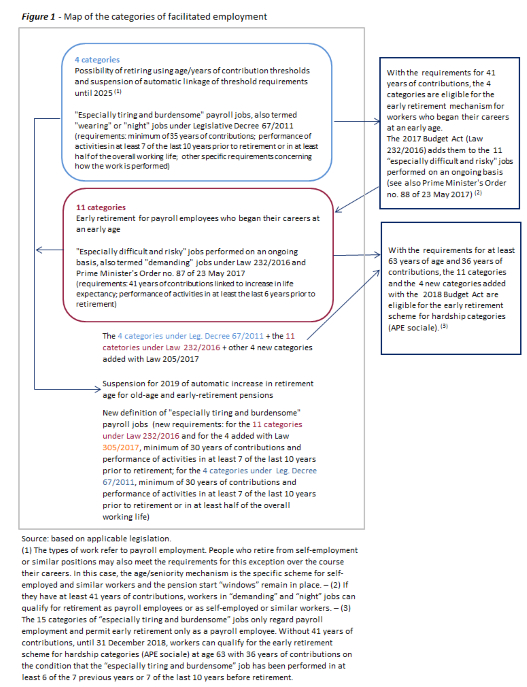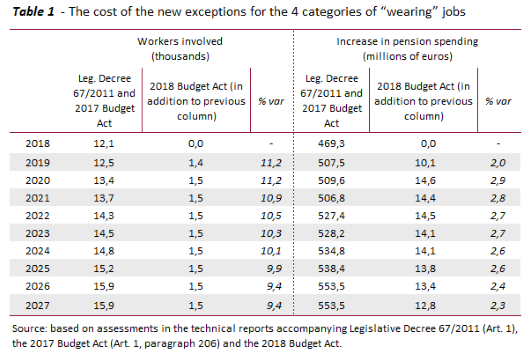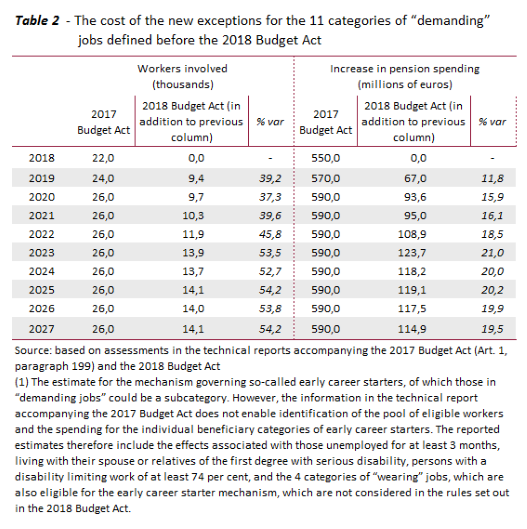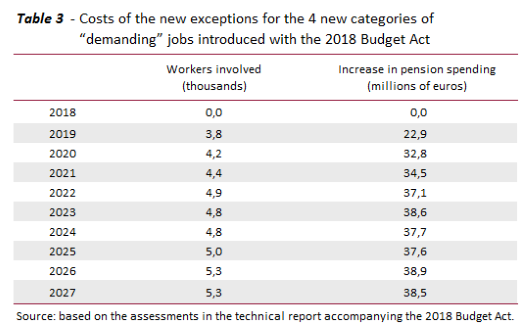The Focus (in Italian) examines the changes introduced with the 2018 Budget Act, which expanded the pool of workers in “especially tiring and burdensome jobs” who can benefit from a suspension of the more stringent pension eligibility requirements provided for in the “Fornero reform” for 2019 in connection with the increase in life expectancy. The new rules regard 15 categories of workers in especially demanding jobs, which overlap to a considerable degree with those already covered by earlier legislation (in particular, the 4 categories of “wearing” and “night” jobs addressed by Legislative Decree 67/2011 and the 11 categories of workers in “demanding” positions provided for in the 2017 Budget Act; see Figure 1).

The technical report accompanying the measure, which quantifies the increase in costs attributable to the new exceptions with respect to those of the existing exceptions, expects the suspension of the provision linking the retirement age to life expectancy to gradually apply to a growing pool of workers – rising from just under 15,000 in 2019 to 20,900 in 2027 – with the cost to the budget increasing from €100 million in 2019 to €176.4 million in 2023, before gradually declining to €166.2 million in 2027 (Tables 1-3). If we also consider the provisions of Legislative Decree 67/2011 and the 2017 Budget Act, the facilitated pension requirements will apply to just over 51,000 workers in 2019 rising to 62,800 in 2027.
The main issues addressed in the Focus are:
- The linking of developments in life expectancy to the minimum pension eligibility requirements and their rise in recent years has led to the introduction in Italy, as in many other countries, of exceptions for specific types of especially “wearing” or “demanding” jobs. These come in addition to the existing sectoral and category exceptions that have to some extent already taken account of the physical burden and danger of certain jobs (including, for example, those for employees of mining, quarry and peat extraction companies with underground works, the defence, security and public rescue sector, pilots and other flight crew, train crews). In other words, account was taken of the fact that the mechanical application of the increase in the retirement age could be an issue if we consider the needs associated with the performance of certain especially demanding jobs or the careers, typically unspecialised, of people who began their working lives at an especially young age.
- In the last decade, there has been a gradual weakening of exceptions for entire categories in favour of those for physically demanding and wearing jobs. Nevertheless, this has occurred without a sufficiently uniform overall design, with the establishment of different pension requirements depending on the type of work.
- The design of these exceptions does not appear to be founded on a preliminary analysis to quantify the effective difficulty of continuing to perform demanding or dangerous tasks or differences in the life expectancies of those working in certain jobs. Indeed, it is not easy to achieve and maintain over time a balance between the number and scope of exceptions and the need to avoid undermining the general architecture of the pension system, jeopardising its sustainability.
- The technical committee on “wearing” and “demanding” jobs established with the 2018 Budget Act could have a decisive role in identifying such activities using the most objective criteria possible and in providing guidance on how to rationalise existing exceptions. However, the time allowed for the committee’s work (its findings must be produced by the end of September 2018) seems too brief to address such a complex issue.
- In general, it would be advisable to reconsider the appropriateness of maintaining the current structure of the exceptions granted to specific sectors and segments. The part justified by the performance of especially dangerous or wearing work could be incorporated, through a more comprehensive conception of burden and danger, in the exceptions introduced in recent years for this type of job. Other special exceptions, which are essentially tied to the fact of belonging to a given category regardless of the special features of the work performed, could instead be replaced by labour market instruments for the efficient redeployment of workers. This could take the form of specific agreements between labour and employers that provide for the performance of less physically demanding duties at a certain point in a worker’s career, duties for which experience plays a key role and is a source of positive externalities for production processes. More generally, a more flexible labour market in the final stages of a career could enable certain types of worker to perform their duties in a less demanding manner and provide for specific positions responsible for the transmission of knowledge and experience to younger workers. This would help narrow the scope of the exceptions and exemptions and make it possible to focus efforts on the most significant and urgent cases.



